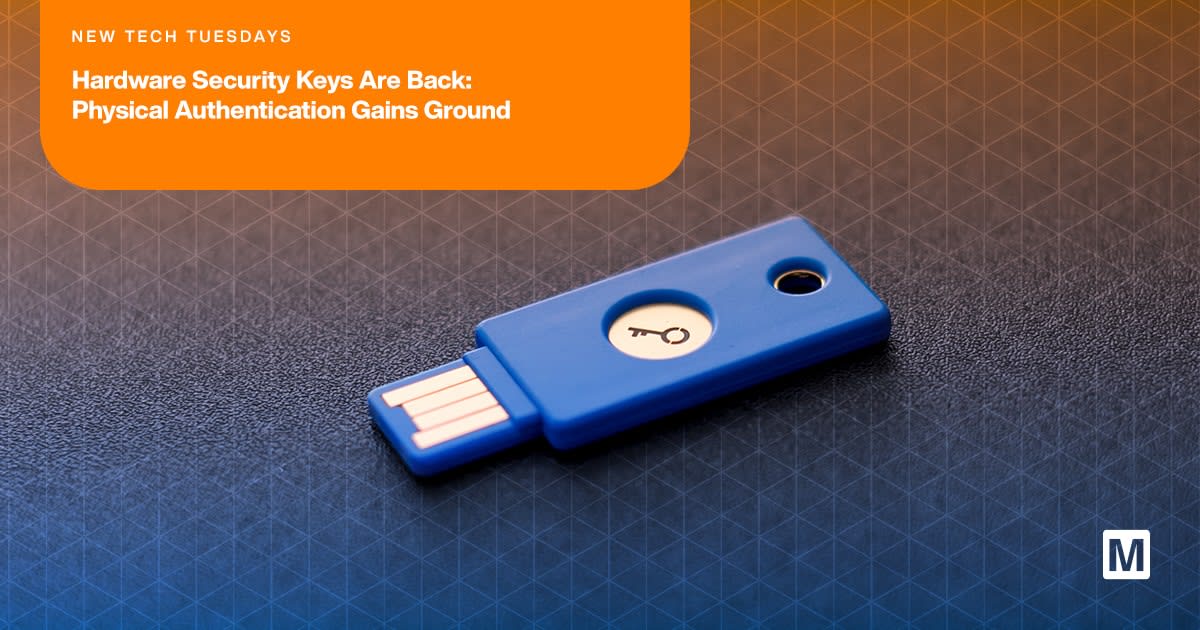New Tech Tuesdays: Hardware Security Keys Are Back: Physical Authentication Gains Ground

New Tech Tuesdays
Join Mouser's Technical Content team for a weekly look at all things interesting, new, and noteworthy for design engineers.
Passwords have ruled the day for some time, but now hardware security keys are making a comeback. As phishing attacks get smarter and password breaches continue to top the list of cybersecurity incidents, there’s a renewed interest in physical authentication. The past decade focused on moving security to the cloud, but current cybersecurity trends are bringing protection back into the user’s hands.
This week’s New Tech Tuesdays examines how the resurgence of hardware security keys is taking shape and the authentication technology changing security solutions.
How Hardware Security Keys Are Changing Authentication
Hardware security keys are physical devices that verify identity when a user logs in, either as a sole credential (e.g., passwordless login) or an extra step in multi-factor authentication (MFA). They use public-key cryptography, a method that pairs a distinctive private key stored safely on the device with a corresponding public key registered to the user’s account.
When a user tries to log in, the website or service sends a cryptographic challenge. The key signs it with its private key, never exposing that private key to the internet, and proves that the user is who they claim to be. This approach makes it almost impossible to steal credentials remotely, even if the cyberattack tricks someone into visiting a fake login page.
Two major standards are involved in making this work: Fast IDentity Online 2 (FIDO2) and Universal 2nd Factor (U2F). FIDO2 and the related WebAuthn API allow for passwordless login and secure MFA for browsers and operating systems. Meanwhile, U2F is the original standard from the FIDO Alliance and is still supported by many services.
Modern keys (Figure 1) can connect via USB-A, USB-C, Lightning, or near-field communication (NFC), so they are compatible with desktops, laptops, and smartphones.

Figure 1: An NFC-enabled security key, such as the Swissbit iShield key series, authenticates a smartphone without a physical connection, enabling quick, contactless logins. (Source: Mouser Electronics)
Trends Driving the Resurgence
Several trends are driving the renewed interest in hardware security keys:
- Phishing resistance is a necessity. Artificial Intelligence (AI) is becoming increasingly sophisticated, enabling phishing campaigns that can mimic legitimate sites and emails very accurately.[1] Hardware keys block these attacks by requiring cryptographic authentication tied to the real domain. So even if a user clicks a bad link, it won’t work.
- People are getting password fatigue. Users have so many accounts, each with complicated password rules,[2] and this growing complexity is making passwordless methods appealing. A hardware key can replace passwords entirely for supported services, so logins are faster and safer.
- There are growing regulations. Finance, healthcare, and critical infrastructure sectors are now mandating phishing-resistant authentication for certain accounts.[3] Hardware keys are a simple way to meet these standards.
- Enterprise security is making its way into consumer devices. Smartphones, laptops, and everything in between are now shipping with secure element chips.[4] These chips are the same kind of tamper-resistant technology that’s in hardware keys, making for a smooth transition into physical authentication.
Who’s Using Hardware Security Keys?
For years, tech companies and high-security environments have been the typical places for hardware security keys; however, in 2025, this is spreading to other applications. For example, journalists in high-risk regions rely on keys to secure email, messages, and storage from surveillance or cyberattacks.[5] Patient records in healthcare settings are under constant threat, so hospitals are issuing their staff hardware keys to prevent phishing attacks that could compromise sensitive data.[6] Investors are adopting hardware keys to lock down accounts, so if an attacker steals credentials, they can’t complete a withdrawal without the key.[7] Corporate remote workforces are even mandating hardware keys for virtual private network (VPN) and internal system access to reduce the breach risks that come with compromised home networks.[8]
The Newest Products for Your Newest Designs®
Phishing-resistant authentication is driving demand for products that are compatible across various devices, platforms, and environments. The Swissbit iShield Key Series USB/NFC security key is a compact, rugged authentication device designed for passwordless login and multi-factor authentication. It combines a secure element chip with FIDO2 and U2F protocol support to deliver phishing-resistant logins across computers, mobile devices, and online services. The key’s dual-interface design allows it to connect via USB-A or USB-C for desktops and laptops, or NFC for contactless authentication with smartphones and tablets. These security keys are water- and dust-resistant, support storage of up to 300 passkeys, and can also be configured for smartcard (PIV) and one-time password (OTP) functions. Built to meet FIPS 140-3 Level 3 certification, they are suited for both enterprise deployments and individual security needs.
Tuesday’s Takeaway
A single password is not enough. As cyber threats get more sophisticated, hardware security keys are a simple, proven, and effective layer of defense.
With increasing enterprise and consumer adoption, paired with support for standards like FIDO2 and built-in secure elements, hardware keys are becoming the go-to solution for next-gen authentication.
Sources
[1]https://hoxhunt.com/blog/ai-powered-phishing-vs-humans
[2]https://nordpass.com/blog/how-many-passwords-does-average-person-have
[3]https://www.yubico.com/resources/glossary/strong-authentication/
[4]https://www.tropicsquare.com/blogs/what-is-a-secure-element-and-why-should-you-care
[5]https://www.yubico.com/resources/reference-customers/radio-free-europe-radio-liberty-case-study
[6]https://cloudsecurityalliance.org/blog/2023/04/05/mfa-for-hospitals-password-sharing-workstations-and-other-challenges
[7]https://www.xapobank.com/en/blog/introducing-hardware-security-keys-with-xapo
[8]https://www.yubico.com/solutions/secure-hybrid-and-remote-workers